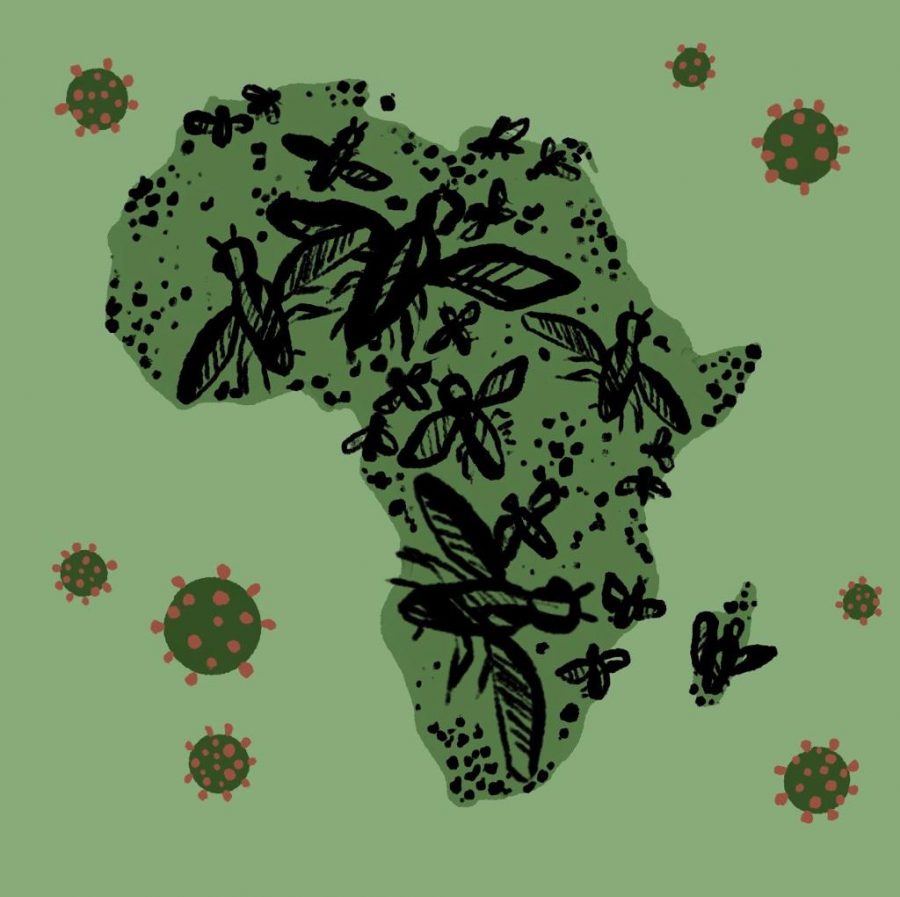Locusts take Africa by swarm
Athmika Sriram
As the threat of COVID-19 continues, locust swarms add more pressure to African society.
May 26, 2020
Eastern African countries are losing the ability to handle the recent locust swarms as more of their resources are diverted to the coronavirus.
Locusts are a distant relative of the grasshopper that are usually low in number and don’t normally pose an economic threat to agriculture. Locusts also look like grasshoppers in that they have two hind legs that help them jump or hop. However, their behavior is drastically different from that of the grasshopper, varying according to the climate that surrounds them. During the hotter times, locusts are forced together in patchy areas, essentially forcing them to release a lot of serotonin.
When it rains, this scenario worsens. With the production of moist soil and abundant green plants, the locusts reproduce rapidly. The solitary locusts then adapt to a group lifestyle. This shift is known as the gregarious lifestyle, and during this time, their endurance and brain size increase.
There are many types of locusts present throughout different areas, but the swarms in Africa are specifically Desert Locusts. These locusts have plagued Africa for a long time; last year, a swarm detected in Kenya was three times the size of New York. And things haven’t gotten any better this year.
The biggest reason for the sharp spike in locust numbers is global warming. Many believe that locust outbreaks might be driven by the shifts of plant nutrients and extreme weather.
Ellie Welti, a biologist from the University of Oklahoma, believes there is a strong relationship between plants, weather, and insects. The more it rains, the more it is a breeding ground for these insects, and due to extreme weather fluctuation it is impossible to predict what the locusts will do.
She further states that the current outbreaks of locusts can be linked back to alarming global warming and will have varying impacts on the ecosystem.
The outbreaks were set up by heavy rainfall in late 2019, followed by a cyclone in the West Indian ocean that brought in additional rainfall. Studies have shown that human-driven warming might be a leading cause of the unrest in the Indian Ocean. This sudden rain created the perfect situation for locust swarms to grow and destroy crop yield.
Although these locusts individually seem like less of a threat, the swarms overall have wrecked extreme havoc across the African continent, specifically in terms of economics. In an article for CNBC, Elliot Smith explains how the locusts are significantly decreasing the capability for agricultural production.
Smith says, “The FAO estimated that 70,000 hectares of crops in Kenya and around 30,000 hectares in Ethiopia had been infested. It added that locusts had attacked coffee and tea crops that account for approximately 30% of Ethiopia’s exports.”
And as Claudia Lacave explains in an article for AfricaReport, agriculture made up 26% of Kenya’s GDP in 2019, making it a key sector in the economic wellbeing of countries like Kenya.
Yet these locusts do not just have a direct impact on the agriculture and crops they infest. Thomas Miers in an article for PreventionWeb quantifies this impact, explaining that DLC, or desert locust control, in Africa has used up almost 38 million USD per year on average, 40% of which has come from international assistance.
Unfortunately this amount of aid flowing into Africa does not seem to be enough to control the situation. The FAO or Food and Agriculture Organization of the United Nations has requested 138 million USD in funding and international assistance to deal with the crisis.
This funding from countries outside of Africa has played an essential role in helping to suppress the locust crisis, and this aid has become exponentially more important, especially with the coronavirus. Although the coronavirus has not changed the locust swarms themselves, it has changed the capability that countries hold for dealing with the locusts.
For example a CNBC article explains, “Officials in Kenya cited difficulties in fighting the infestation as coronavirus-related travel restrictions slow cross-border travel and delay the delivery of pesticides.”
These locust swarms have hindered responses from governments in East Africa. Locust swarms have existed for a long time, yet the reason why they appear to be hitting economies especially hard this time is due to external threats from the virus.
However, there is a bright side to the situation. According to Cyril Ferrand, the East Africa resilience team leader for the FAO, food supplies are not being hit too hard at the moment.
“Our concern is for the season to come, there could be up to 100% losses. That’s very clear,” said Ferrand.
Despite the existence of coronavirus, Kenya and other countries were luckily able to still have a good response time to the locust swarms. Even while countries are dealing with the coronavirus, it seems that with international assistance and proper methods to control and contain the locusts, there is still a chance to save East African economies.
These locust crises aren’t a new issue to humanity. However, this just might be the first time that multiple crises are happening simultaneously, exacerbating the situation.



